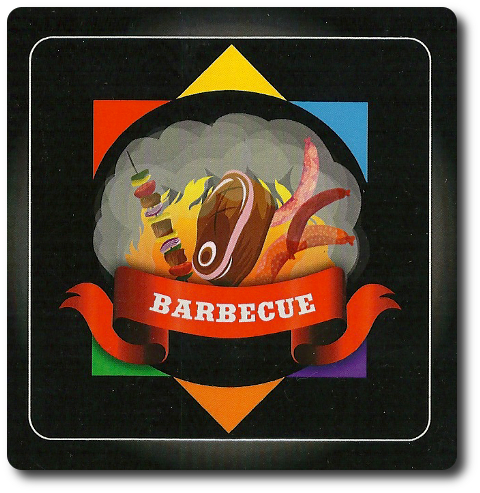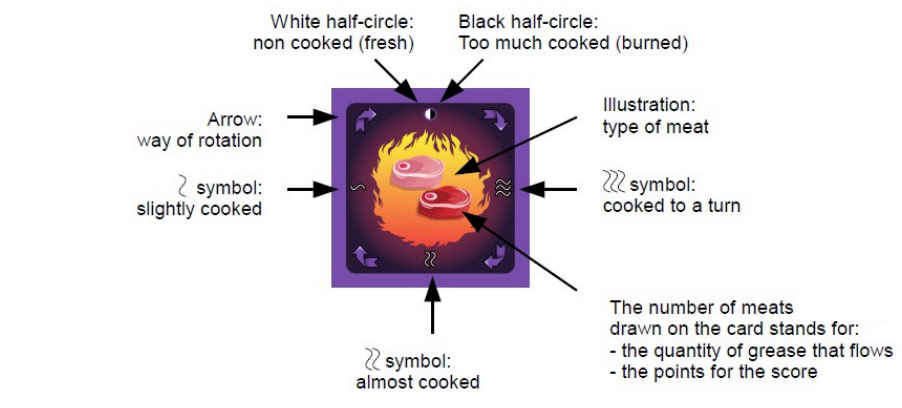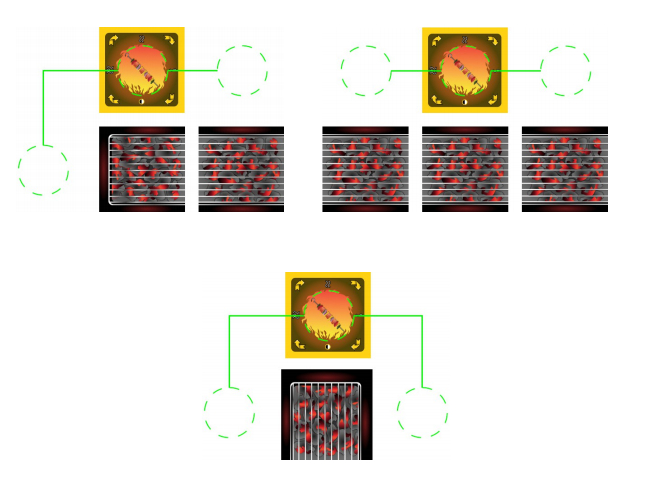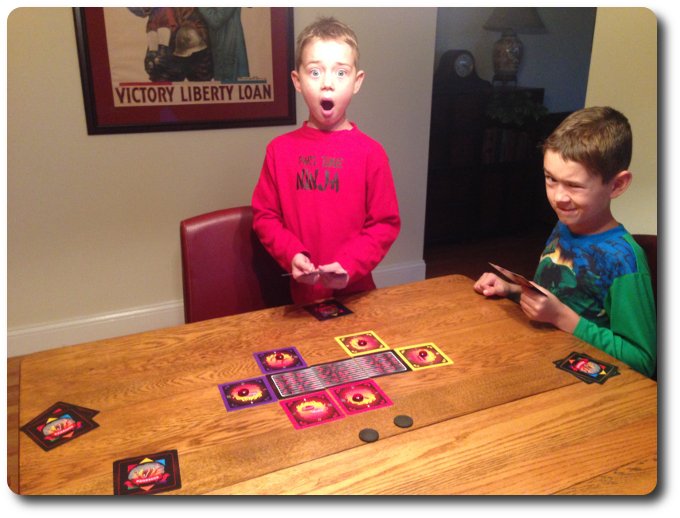
The Basics:
- For ages 7 and up (publisher suggests 12+)
- For 3 to 6 players
- Approximately 20 minutes to complete
Geek Skills:
- Counting & Math
- Logical & Critical Decision Making
- Strategy & Tactics
- Hand/Resource Management
Learning Curve:
- Child – Easy
- Adult – Easy
Theme & Narrative:
- Cook your meats to perfect before an opponent burns you
Endorsements:
- Gamer Geek approved!
- Parent Geek approved!
- Child Geek mixed!
Overview
Grilling is an art form. One must prepare the meat, the grill, and oneself before lighting the fire and grabbing the grill tongs. Ever since the day Neanderthals figured out that meat tasted better when dropped in the fire, humanity has gathered around open flame to watch grease pop, meat sizzle, and vegetables roast. The grill has become something of a social oasis that we gather around, share ideas, and breath in the smells of the meal that is being prepared. It’s also stressful as hell. Cook your meat wrong and you’re going to be ordering pizza. In this game, you have to step up to the grill and face the heat or get burned.
Barbecue, a self-published game by Xavier Lardy via the Game Crafter, is comprised of 36 Meat cards (6 cards per player), 6 Barbecue cards, 8 Braising tokens, and 2 Smoking tokens. The cards are square-shaped, colorful, and durable. The Braising tokens are red glass beads and the Smoking tokens are a black chip.
Preparing the Grill
To set up the game, first find the two ends of the Barbecue cards. Then add 1 additional Barbecue card until the total number of Barbecue cards is equal to the number of players. Arrange the Barbecue cards in the middle of the playing area so it forms one large grilling area. Any Barbecue cards not used are returned to the game box.
Second, place 2 Braising tokens on each end of the Barbecue cards and 1 Braising token on each of the Barbecue cards in between. Set the Smoking tokens to one side of the playing area (use 1 for a 3 to 4 player game and 2 for a 5 to 6 player game). Any Braising or Smoking tokens not placed are returned to the game box.

Example of a 4-player game set up with Braising tokens placed on the Barbecue cards
Third, separate the Meat cards by color and allow each player to take all 6 cards of the color of their choice. Any Meat cards not selected are returned to the game box.
Fourth, players shuffle their Meat cards and place them face-down to create their Meat draw deck.

Fifth, each player draws 2 cards from their Meat draw deck, making sure to keep them hidden from their opponents at all times.
That’s it for game set up. Let’s grill some meat!
The Subtle Art of Grilling
Barbecue is played in turns with no set number of turns per game. On a player’s turn, they will complete the following steps in sequential order.
Step 1: Cook Tasty Meats
The first thing a player does is cook all their Meat cards that are currently on the grill AND have a Braising token on them. Each Meat card has an arrow that shows in what direction the Meat card should be rotated one-quarter turn clockwise. Meat cards that have a Braising token and a Smoking token are turned, as well.
If the Meat card has rotated past a full turn (rotated 4 times, returning the Meat card to its starting position at the grill), it’s considered burnt. The Meat card is flipped over and remains face-down on the same spot. If a Braising token is on the now burnt Meat card, it’s returned to the Barbecue card it’s next to. If a Smoking token is on the now burnt Meat card, it’s also removed and set aside.
Step 2: Score Meat or Add Meat
The player has a choice of two actions they can take during this step, but only one can be taken. If the player is unable to complete both of the two actions, they skip this step, but they must take an action if possible.
If the player has a Meat card that has rotated a whole turn (rotated 3 times), it’s fully cooked and can now be removed from the grill, but only if it doesn’t have a Smoking token on it. Icons are printed on the card to help identify if a Meat card is ready to be removed. Only 1 Meat card can be removed on the player’s turn. When removing a Meat card, the Braising token is returned to the adjacent Barbecue card and the now scored Meat card is placed in the player’s Score pile, face-down.
If the player doesn’t have any Meat cards to score or chooses not to score a Meat card, they can add 1 Meat card from their hand to any open Barbecue card space. When placing a Meat card, it should be placed adjacent to the open Barbecue card and the white/black circle located at the top of the Meat card should be adjacent to the Barbecue card, as well. Face-down Meat cards are considered an open space.
And here’s where things get tricky…
After placing a Meat card, the players must check to see if a grease fire roars to life. Grease fires are NOT a good thing, but they can be used to cook Meat cards indirectly and burn an opponents’ Meat cards to a smoldering ruin. To determine if a grease fire ignites, the number of meats on the Meat card just added and the meats on the Meat cards adjacent to the new Meat card (left and right) are counted. In addition, any burnt Meat cards that the Meat cards are on or are adjacent to the new Meat card add a +1 to the total count. If the total number is 6 or higher, the grill bursts into flames. If lower than 6, the player moves on to the next step.

Where to check for grease fires
Grease fires cause the newly placed Meat card and the two adjacent Meat cards to immediately cook and rotate one-quarter turn. Meats that are burnt are flipped over and any Braising tokens are returned to the adjacent Barbecue card. Finally, the player who started the grease fire takes any Smoking token (be it on another Meat card or off to the side of the game) and places it one of the Meat cards caught in the grease fire. The player cannot place the Smoking token on burnt meat and only 1 Smoking token can be on a Meat card at a time. It is possible that the player might have to place the Smoking token on their own Meat cards.
Step 3: Move One Braising Token
During this step, the player can remove or add 1 Braising token to or from their Meat card. Thematically speaking, the player is moving their meat to a colder or hotter part of the grill, but the meat is still on the grill and can be caught by a grease fire. The Braising token must be adjacent to the Meat card to be taken and removed Braising tokens are placed on adjacent Barbecue cards.
Note that the player cannot move a Braising token to or from a Meat card that has a Smoking token on it. Additionally, only 1 Braising token can be on a Meat card at a time, but the Barbecue cards have no such limits.
Step 4: End of Turn
Finally, the player can take a step back from the grill and catch their breath. If the player placed a Meat card during step 2, they draw 1 Meat card from their Meat draw deck if possible. This concludes the player’s turn. The next player in turn order sequence now goes, starting with step 1 noted above.
Time to Eat
The endgame is triggered after each player has played their sixth Meat card to the grill. When the final player plays their sixth and final card, every player is given 1 more turn. Obviously, during step 2, they cannot place a Meat card.
After all the players have completed their final turn, points are scored. All Meat cards placed in the player’s Score pile are counted. Each Meat card is worth a number of points equal to the number of meats on the card (1, 2, or 3 points). Points are totaled and the player with the most points wins the game, as well as getting the title “Lord/Lady of the Grill” for the duration of the day. Ties are broken by counting burnt Meat cards. The player with the fewest wins the game.
Game Variants
Team Play
Two to three equal numbered teams compete to be grill masters. When the game ends, the players on the same team add up their points together. The team with the most points wins the game. This game variant provides for some interesting team work as two or three players have to cook their Meat cards while doing all they can not to burn their team members!
Multiple Games
Instead of determining the winner after a single game, play several. The player with the most game wins is victorious.
To learn more about Barbecue, visit the game’s official web page on the Game Crafter.
Prediction
Oh, I like what I’m seeing.
Barbecue would appear to be a casual game that should be easy enough to teach, but will be much less easy to win. I love games like this. Games that can be set up quickly, explained in a few minutes, and enjoyed by a large group of players. Better yet, the game’s theme is common place enough to make it approachable to non-gamers.
Overall, the game play is pretty straight forward, but the calculation of the grease fires and the lack of Braising tokens has me slightly concerned. Determining if there is a grease fires is not overly difficult, but it does appear to be a bit fiddly to resolve. My concern here is that we will lose the game’s momentum or confused our players when they go to calculate the level of grease on the fire. The lack of Braising tokens means players will not be able to immediately start grilling their meats. If players start to feel left behind, they’ll lose interest.
But let’s pause for a moment and consider these two supposed issues. Lack of Braising tokens suggests that players will not be able to cook their meats. This is not entirely true. Braising tokens allow the player to start cooking their meat on their terms. Utilizing the grease fire is where the game is going to get really interesting. If there are never enough Braising tokens to cook Meat cards, players MUST start a grease fire to get their meats fired up. This would suggest players need to play their Meat cards very carefully and time their fires in order to win the game. Very interesting!
I think all three of groups, Child, Parent, and Gamer Geeks are going to enjoy this game. The designer’s last game, Galipotes, was well received by the majority, but proved to be a game not fully to the Gamer Geeks’ liking. I don’t see anything to suggest that Barbecue won’t challenge and entertain the gaming elitists. It might be a bit tricky for the Child Geeks, though.
Teaching Barbecue is best done by example. Demonstrate how a Meat card cooks and explain how grease fires are started. Everything else can be explained while the game is being played. Note that Barbecue does not require any reading, but does require math. Younger players can play Barbecue if an older player is willing to help add up the meats and tend to the grease fires.
And so, after teaching Barbecue to all 3 of my little geeks, I asked them their thoughts on Barbecue so far.
“This game makes me hungry!” ~ Liam (age 9)
“I will be a grilling machine!” ~ Nyhus (age 7)
“Can we make hamburgers and hot dogs, Daddy?” ~ Ronan (age 4)
Let’s get this grilling party started and see if Barbecue is as hot as I think it is or it burns us.
Final Word
Note: Barbecue can be played with Child Geeks as young as 7 and perhaps a bit younger. Our Child Geeks who were younger than 7 understood the game, but did not demonstrate enough game knowledge and understanding to make us believe they were “getting it”. As always, your results at your gaming table may vary.
The Child Geeks had some problems with this game. While all of our younger players understood how to play the game, they had difficulty reading the table and understanding how things were cooking. According to one Child Geek, “I understand how to cook and to turn, but I keep getting confused with the burning and smoking.” Another Child Geek said, “I don’t understand how to not burn my meat.” There’s an important point to make here. While Barbecue is an easy enough game to teach and to grasp, it can be tricky to evaluate how badly things are about to get on the grill. This caused confusion and a great deal of delay at times when the Child Geeks had to calculate the level of “burnination” (as one Child Geek put it), but not all the Child Geeks had difficulty. The older Child Geeks, in fact, had no problems with the game and were able to quickly determine how much grease and smoke were on the grill. According to one of the older Child Geeks, “I really like this game. It’s fast and makes you hungry.” When all the votes were counted, the Child Geeks had mixed feelings about Barbecue.

Guess which little geek just figured out he was about to start a HUGE grease fire…
The Parent Geek adored Barbecue. They found it to be an interesting game that kept them engaged from start to finish. According to one Parent Geek, “This game starts small and quickly grows in intensity. I had no idea how intense it could be to grill!” Another Parent Geek said, “This is a very interesting game. At first, I didn’t know how I was going to get all my meat cooked. Thanks to some lucky grease fires, I did pretty well.” All the Parent Geek agreed that Barbecue was a unique Card game they enjoyed playing and would enjoy playing again.
The Gamer Geeks enjoyed Barbecue, as well. According to one Gamer Geek, “This is a pretty clever game. You have to manage your hand, your cooking meats, your neighbors’ cooking meats, and the grill. All at the same time!” Sounds overwhelming, doesn’t it, but the Gamer Geek relished the challenge. Another Gamer Geek said, “The best part of this game is the controlled burn you have to administer to your meats. Every time I play this, I think of something else I want to try. For example, cooking on 2 burnt Meat cards for some quick points!” All the Gamer Geeks found Barbecue to be a casual, yet intense game of meat management.
All our players discovered that there is much more to the game than just playing cards. You have to manage a great deal in a very subtle way. Not once did I see any of our players become overwhelmed, because their choices were always few. What they all found out – and quickly – is that every action resulted in an effect. Depending on the effect, there might be good or bad consequences on the grill. For example, starting a grease fire on purpose sounds like a really bad idea, but it’s also a great way to speed up your cooking and reduce an opponent’s points. The Smoking token needs to be thoughtfully placed, as well. Before placing it, keep in mind that the Meat card that it’s attached to is “stuck” on the grill until it’s removed. This a great way to pin an opponent down AND create a hot spot on the grill.
I don’t think Barbecue is a game that is out of reach for the Child Geeks. My two oldest Child Geeks (ages 7 and 9 at the time of this review) had no problems playing the game. Admittedly, they have played a lot of games, which might account for their ability to quickly grasp the game’s concept and play, but Barbecue is not a difficult game to understand to begin with. The most difficult aspects of this game are calculating grease fires and keeping track of all the grilling meats.
Which is exactly like real life.
I don’t know about you, but grills terrify me. As soon as you put the meat over the heat, it’s GO TIME. How long should you keep it on the grill? When should you turn it? Where is the grill’s hot spot or cold spot? Is the meat done? Why is my grill on fire? These are all questions that run through my head and it has gotten to a point where my wife is fed up with my little panic attacks. As such, I’ve been demoted to “Salad Maker” and “Hamburger Bun Organizer”.
Barbecue captured a bit of the mania that comes with grilling and all of the triumph of beautifully cooked meats. When you score a 3 Meat card, you can’t help but feel a little like a grilling badass. Mostly because a 3 Meat card tends to cause a lot of grease fires and are difficult to score. When your meat goes up in smoke or burns into a dry, black husk, the card is left on the table as a reminder of your unworthiness to wear a grilling apron. In this game, you “feel” the heat that emanates from the grill and the competition as everyone jockeys their meats around the barbecue to find the perfect grilling spot.
I’ll be the first to admit that I never thought a game about grilling would be entertaining, but Barbecue has changed my mind. This is a really fun game, light, and casual with the perfect level of intensity. From the very start, you know that you will have to compete and players will be sitting forward and studying the grill from start to finish. Barbecue is a great game and I recommend you give it a try when you have the opportunity. Celebrity chef Bobby Flay said, “I love the culture of grilling. It creates an atmosphere that is festive but casual.” The same could be said about Barbecue, except no fires are involved. Feel free to wear an apron if you think it’ll help your odds of winning.
This game was given to Father Geek as a review copy. Father Geek was not paid, bribed, wined, dined, or threatened in vain hopes of influencing this review. Such is the statuesque and legendary integrity of Father Geek.
Discover more from Father Geek
Subscribe to get the latest posts sent to your email.



Pingback: In Review: Father Geek’s Monthly Newsletter (August 2014) - Father Geek
Pingback: In Review: Father Geek’s Monthly Newsletter (September 2014) - Father Geek